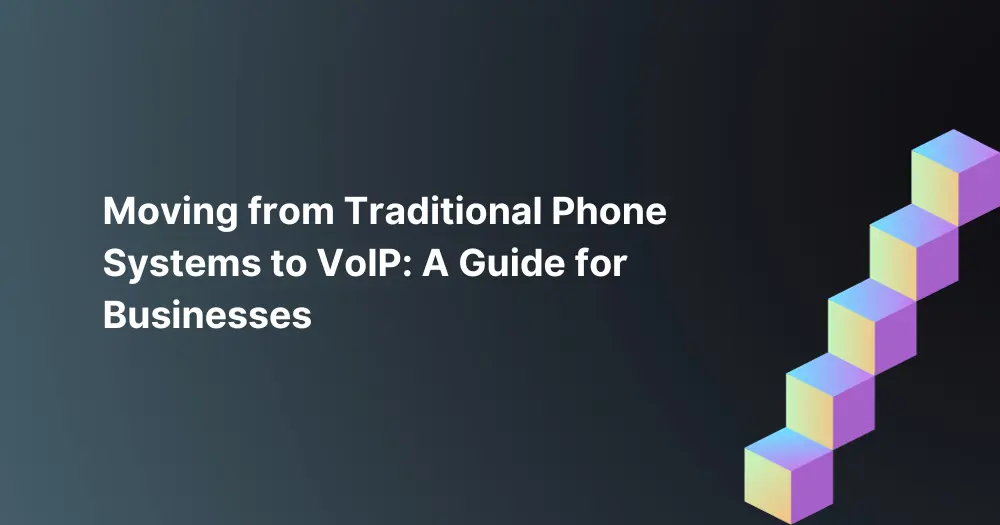
Phone calls will always be as important as before, even with numerous digital communication solutions at arm’s reach. It provides a personalized touch that today’s digital solutions struggle to replicate.
The prevalence of these new solutions has made traditional phone systems obsolete. With legacy phone systems only offering limited features, more and more businesses have switched to unified communication solutions to future-proof their communication strategy.
Voice over Internet Protocol (VoIP), at the forefront of unified communications, has made it much easier for businesses to keep up with the changing business landscape and continue offering efficient communication, allowing customers and employees to strengthen their interactions.
This blog will guide you to easily transition from traditional phone systems to VoIP.
Before switching to VoIP, a deep understanding of your overall business needs and objectives will help you reach a more informed decision as you move towards digitalization.
Clearly defining your business needs and objectives will help you implement the right technology strategy. Functionality, reliability, and budget are just some of the considerations you need to take note of. So, take time to reflect on what you want to achieve and use it as your guide towards a successful communication transformation.
Functionality: Does your current phone system not offer specific call features you would want to have? If you feel that your communication strategy is hindered due to your legacy systems’ limited capabilities, switching to VoIP would be better. VoIP allows you to choose more advanced features along with standard features like call management, voicemail, conference calling, video calling, and instant messaging.
Reliability: Not all businesses would benefit from VoIP. If you are in an area where the Internet is weak or wonky, you might not be able to fully optimize the use of VoIP. On the other hand, VoIP offers uptime and minimizes disruptions to locations with strong network connections.
Budget: Take into account the operational expenses of maintaining and upgrading your phone systems. If you require advanced call features, it would be better to avail an all-in-one solution instead of keeping your traditional lines and getting another communication setup. Consider additional expenses like installation fees, hardware charges, and maintenance costs.
Your chosen VoIP provider will act as your technology partner, ensuring the smooth transition and management of your new VoIP system. Look for one that offers scalable solutions, 24/7 support, and quick resolution times. They should prioritize network reliability and have robust security measures in place.
Conducting a network assessment helps identify and address the potential challenges you may face before jumping into a new VoIP system. This assessment dives deeper into the capabilities of your current system—whether your network has sufficient bandwidth capacity to support VoIP. It also identifies latency issues and areas of congestion that could impact VoIP performance.
Depending on your chosen VoIP solution and provider, you may need to set up hardware such as IP phones or install software applications on your existing device. It could be overwhelming, especially for teams without skilled IT and communication support.
This step is where BlackPoint IT comes in handy. We handle the migration process to VoIP, making it an easier and more seamless transition. From installation, configuration, testing, and management, you won’t need to worry—our technical experts will do all the work for you.
After setting up, you must configure your VoIP system settings and tailor them to your specific communication needs. This process involves customizing your system’s various aspects, including user profiles, caller routing rules, voicemail greetings, call forwarding, and other feature preferences.
Conduct thorough testing before fully implementing your new phone system to ensure proper functionality and call quality. It lets you identify technical or operational issues, misconfigurations, or compatibility challenges. Testing allows you to minimize disruptions and resolve any other issues for a smooth transition.
Train users to fully utilize the capabilities of VoIP. Provide training for VoIP’s essential functions, advanced features, basic troubleshooting, and security awareness. Investing in comprehensive training empowers your employees to make the most out of your VoIP system and minimizes reliance on your IT support for routine tasks.
Porting your existing phone numbers allows your clients to reach you with the same business number you used with a traditional phone line. This step requires assistance from your provider to port them over to your new system.
Gradually implementing your new VoIP system allows your users to adjust and adapt to the new system. Continuously monitor your VoIP system’s performance and address issues immediately. Ask for user feedback to make necessary adjustments and further improve its performance.
Moving from a traditional phone system to VoIP can be challenging, yet its rewards overcompensate for the challenges of the transition. VoIP allows you to future-proof your business communication strategy and offers a more unified communication experience.
Are you ready to take your business communications to new heights? There is no need to worry about the transition; BlackPoint IT offers end-to-end VoIP management that other companies don’t usually offer. We will handle everything from installation, configuration, management, and monitoring. All you have to do is sit back and relax as we future-proof your communications. Contact us for a consultation.